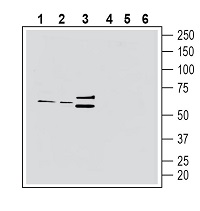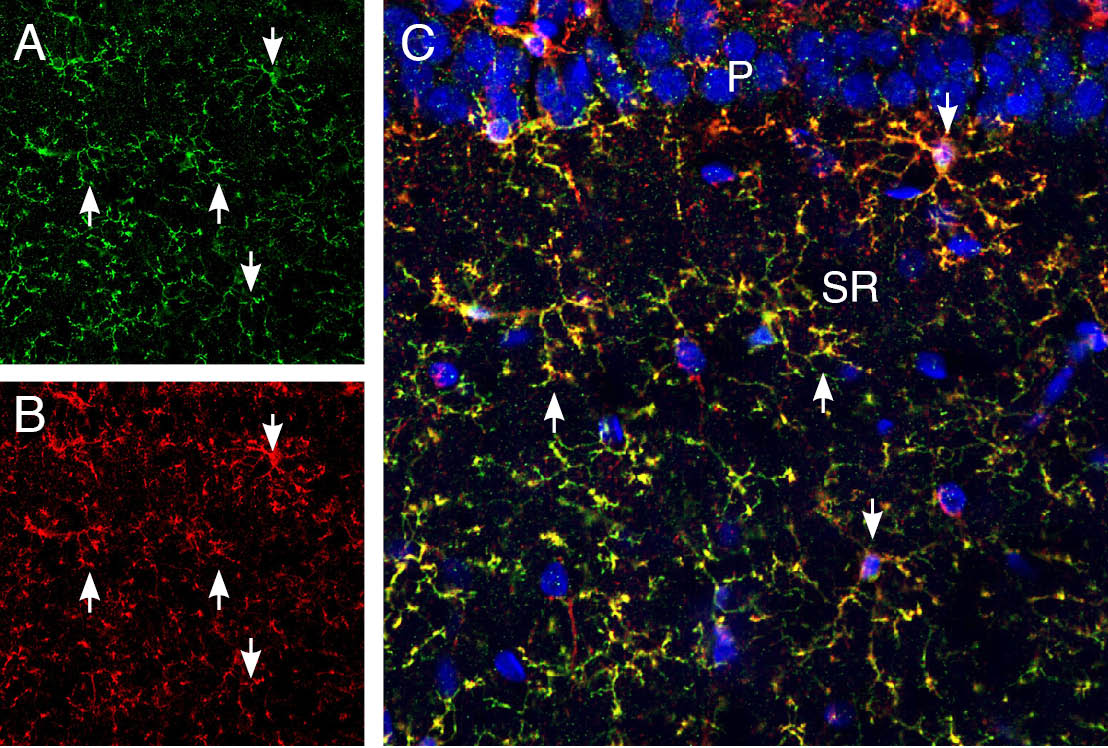Overview
Cat #: BLP-CR058
Type: Synthetic peptide
Form: Lyophilized Powder
CX3CR1 (extracellular) Blocking Peptide (#BLP-CR058) is the original antigen used for immunization during Anti-CX3CR1 (extracellular) Antibody (#ACR-058) generation. The blocking peptide binds and ‘blocks’ Anti-CX3CR1 (extracellular) primary antibody, this makes it a good negative reagent control to help confirm antibody specificity in western blot and immunohistochemistry applications. This control is also often called a pre-adsorption control.
Applications: wb, ihc
Application key:
WB- Western blot, IHC- Immunohistochemistry
For research purposes only. not for human use
Applications
Demonstration of Pre-adsorption control
 Western blot analysis of rat brain lysate (lanes 1 and 4), mouse brain membranes (lanes 2 and 5) and rat spleen lysate (lanes 3 and 6):1-3. Anti-CX3CR1 (extracellular) Antibody (#ACR-058), (1:200).
Western blot analysis of rat brain lysate (lanes 1 and 4), mouse brain membranes (lanes 2 and 5) and rat spleen lysate (lanes 3 and 6):1-3. Anti-CX3CR1 (extracellular) Antibody (#ACR-058), (1:200).
4-6. Anti-CX3CR1 (extracellular) Antibody, preincubated with CX3CR1 (extracellular) Blocking Peptide (#BLP-CR058). Western blot analysis of mouse BV-2 microglia cell line lysate (lanes 1 and 3) and mouse J774 macrophage cell line lysate (lanes 2 and 4):1, 2. Anti-CX3CR1 (extracellular) Antibody (#ACR-058), (1:200).
Western blot analysis of mouse BV-2 microglia cell line lysate (lanes 1 and 3) and mouse J774 macrophage cell line lysate (lanes 2 and 4):1, 2. Anti-CX3CR1 (extracellular) Antibody (#ACR-058), (1:200).
3, 4. Anti-CX3CR1 (extracellular) Antibody, preincubated with CX3CR1 (extracellular) Blocking Peptide (#BLP-CR058). Expression of CX3CR1 in rat hippocampusImmunohistochemical staining of perfusion-fixed frozen rat brain sections with Anti-CX3CR1 (extracellular) Antibody (#ACR-058), (1:300), followed by goat anti-rabbit-AlexaFluor-488. A. CX3CR1 staining (green) in the hippocampal CA1 region is detected in microglial profiles in the stratum oriens. Some profiles include the entire microglial outline including soma (horizontal arrows) while other outlines are processes (vertical arrows). B. Pre-incubation of the antibody with CX3CR1 (extracellular) Blocking Peptide (#BLP-CR058), suppresses staining. Cell nuclei are stained with DAPI (blue). P = pyramidal layer, SR = stratum radiatum, SO = stratum oriens.
Expression of CX3CR1 in rat hippocampusImmunohistochemical staining of perfusion-fixed frozen rat brain sections with Anti-CX3CR1 (extracellular) Antibody (#ACR-058), (1:300), followed by goat anti-rabbit-AlexaFluor-488. A. CX3CR1 staining (green) in the hippocampal CA1 region is detected in microglial profiles in the stratum oriens. Some profiles include the entire microglial outline including soma (horizontal arrows) while other outlines are processes (vertical arrows). B. Pre-incubation of the antibody with CX3CR1 (extracellular) Blocking Peptide (#BLP-CR058), suppresses staining. Cell nuclei are stained with DAPI (blue). P = pyramidal layer, SR = stratum radiatum, SO = stratum oriens. Multiplex staining of CX3CR1 and CD11b in rat hippocampus.Immunohistochemical staining of perfusion-fixed frozen rat brain sections Anti-CX3CR1 (extracellular) Antibody (#ACR-058), (1:300), followed by goat anti-rabbit-AlexaFluor-488 and mouse Anti -CD11b, (1:500), followed by goat anti-mouse-biotin and streptavidin-Cy3. A. CXCR1 immunoreactivity (green) appears in microglial processes (up pointing arrows) and in full microglial outline (down pointing arrows). B. CD11b immunoreactivity (red) appears in microglial profiles. C. Merge of the two images demonstrates ubiquitous co-localization. Cell nuclei are stained with DAPI (blue). P = pyramidal layer, SR = stratum radiatum.
Multiplex staining of CX3CR1 and CD11b in rat hippocampus.Immunohistochemical staining of perfusion-fixed frozen rat brain sections Anti-CX3CR1 (extracellular) Antibody (#ACR-058), (1:300), followed by goat anti-rabbit-AlexaFluor-488 and mouse Anti -CD11b, (1:500), followed by goat anti-mouse-biotin and streptavidin-Cy3. A. CXCR1 immunoreactivity (green) appears in microglial processes (up pointing arrows) and in full microglial outline (down pointing arrows). B. CD11b immunoreactivity (red) appears in microglial profiles. C. Merge of the two images demonstrates ubiquitous co-localization. Cell nuclei are stained with DAPI (blue). P = pyramidal layer, SR = stratum radiatum.
Properties
Sequence
- Peptide (C)ELDLENFEYDDSAE, corresponding to amino acid residues 7- 20 of mouse CX3CR1 (Accession Q9Z0D9).

Accession (Uniprot) Number Q9Z0D9
Peptide Confirmation Confirmed by amino acid analysis and mass spectrometry.
Purity >70%
Storage Before Reconstitution Lyophilized powder can be stored intact at room temperature for two weeks. For longer periods, it should be stored at -20°C.
Reconstitution 100 µl double distilled water (DDW).
Concentration After Reconstitution 0.4 mg/ml.
Storage After Reconstitution -20°C.
Antigen Preadsorption Control 1 µg peptide per 1 µg antibody.
Standard Quality Control Of Each Lot Western blot analysis.
